REVIEWER'S NOTE: This is the Part IV of my multi-stage 1xAA round-up review, similar to my 2xAA and 1xCR123A/RCR Round-up Review threads.
To compare the current crop of 1xAA lights to earlier lights, please see my earlier 1xAA threads:
Part III: Liteflux LF5; Rexlight 2.1; Jetbeam C-LE v2, NiteCore Defender Infinity; Fenix L1D; Olight T15 (2007); LumaPower LM31; JetBeam Jet-I PRO (R2); Zebralight H50; JetBeam Jet-I MK IBS (Q5)
Part II: Rexlight 2.1; DealExtreme X.1; Jetbeam C-LE v1.2; Fenix L1DCE (Q2), L1D-R100, L1Tv2.0-R080; MTE 5-Stage Cree, 5-Stage R100; Kai 5-Stage Cree; Lumapower LM-301; Liteflux LF5; Ultrafire C3 5-stage
Part I: Rexlight 2.0; DealExtreme X.1, X.V; Jetbeam MK IIX, C-LE v1.0, C-LE v1.2; Fenix L1D-CE (P4)[/I]
For a discussion of the color rendition properties of different emitters and tint bins, please see my comparison thread: Color Rendition and Tint Comparison: Cree, Rebel, GDP, Nichia
Warning: this post is *very* pic and text heavy!
UPDATE June 10, 2009: Added Olight I15 and NiteCore EZAA to the review.
The contenders:
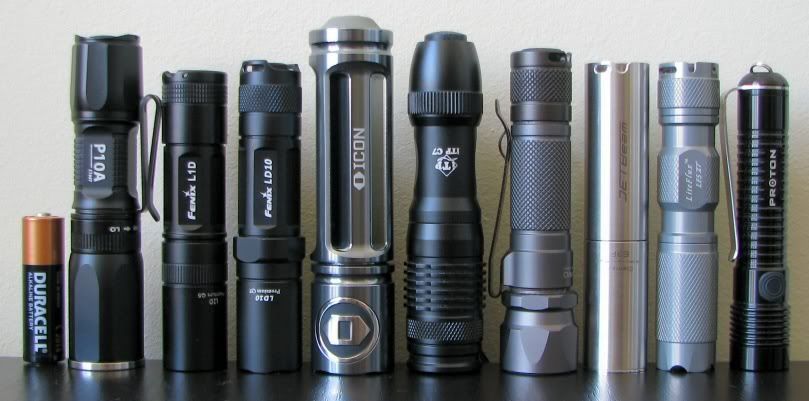

From left to right: Duracell alkaline battery; Eagletac P10A; Fenix L1D, LD10; ICON Rogue 1; ITP C7; JetBeam Jet-I PRO IBS, Element E3P; Liteflux LF5XT; LRI Proton Pro.
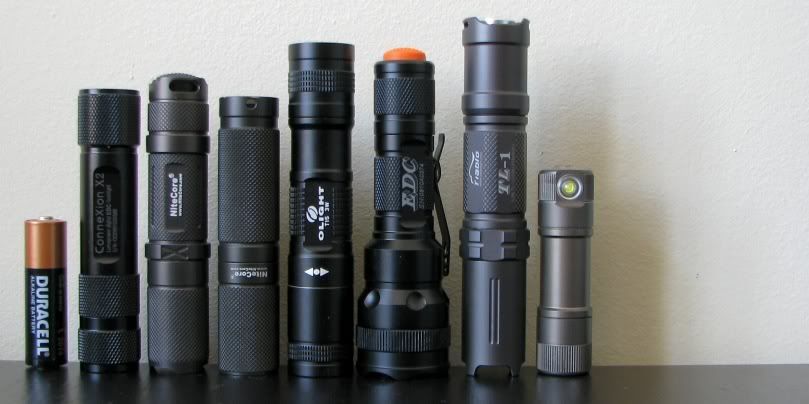

From left to right: Duracell alkaline battery; Lumapower Connexion X2; NiteCore Defender Infinity (NDI), D10-GDP; Olight T15; Regalight EDC; Tiablo TL-1; Zebralight H50.
Not shown are the Olight Infinitum I15 and NiteCore EZAA.
Size and weights (without battery):
Eagletac P10A: 76.1g
Fenix L1D: 48.7g
Fenix LD10: 48.9g
ICON Rogue 1: 85.7g
ITP C7: 76.4g
JetBeam Jet-I PRO IBS: 56.5g
JetBeam Element E3P: 105.0g
Liteflux LF5XT: 53.9g
LRI Proton Pro: 30.3g
Lumapower Connexion X2: 37.4g
NiteCore Defender Infinity: 44.1g
NiteCore D10: 41.3g
NiteCore EZAA: 20.9g
Olight I15: 52.5g
Olight T15: 53.3g
Regalight EDC: 63.6g
Tiablo TL-1: 61.3g
Zebralight H50: 18g
Testing Method: All my output numbers are relative for my home-made light box setup, a la Quickbeam's flashlightreviews.com method. You can directly compare all my relative output values from different reviews - i.e. an output value of "10" in one graph is the same as "10" in another. All runtimes are done under a cooling fan, except for the extended run Lo/Min modes that run for >24hrs - those are done without cooling.
Throw values are the square-root of lux measurements taken at 1 meter from the lens, using a light meter.
Beamshots:
All up-close beamshots are at ~0.5 meter from a white wall, on Max/Turbo/100% with a Sanyo Eneloop (NiMH).
1/25sec, f3.2
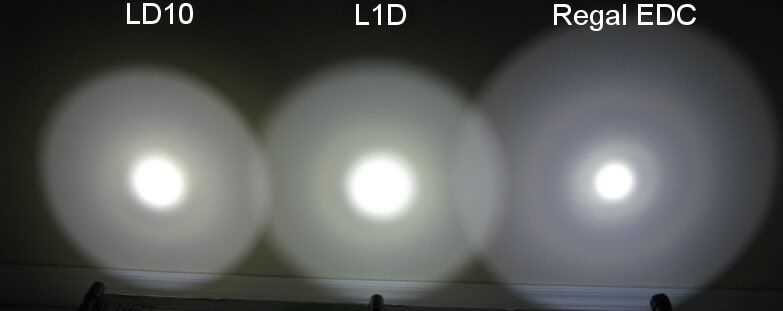
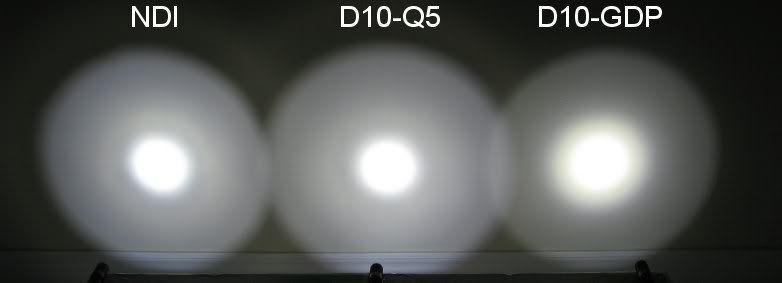
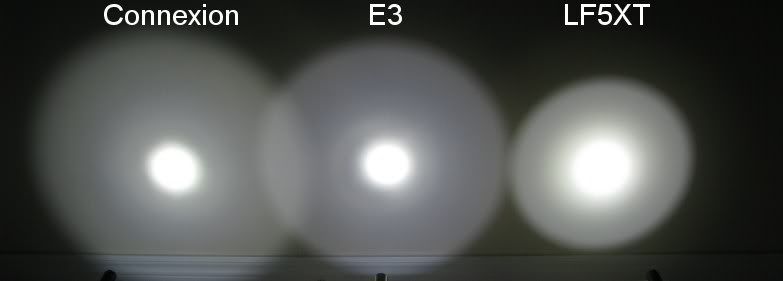
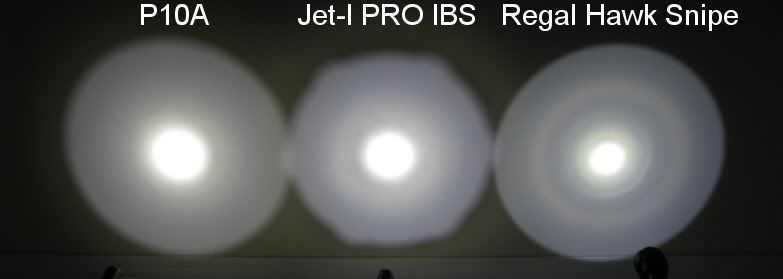
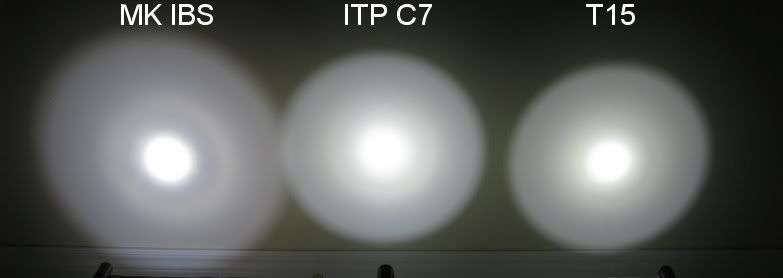
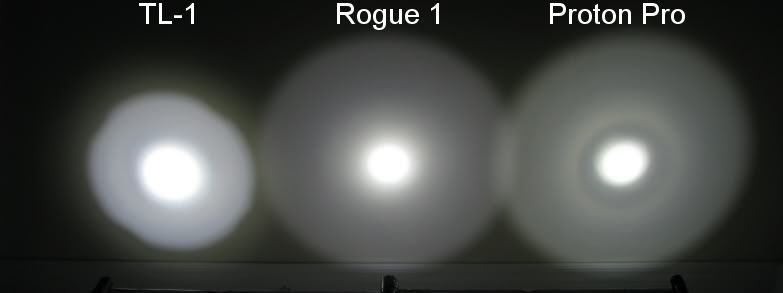
1/100sec, f3.2
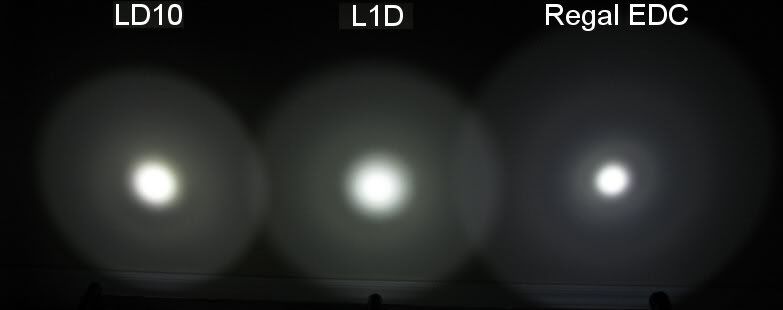
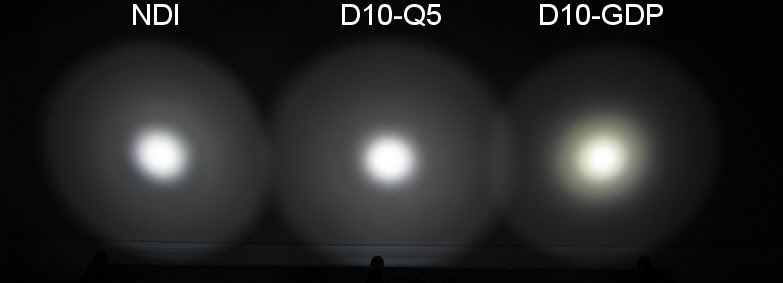
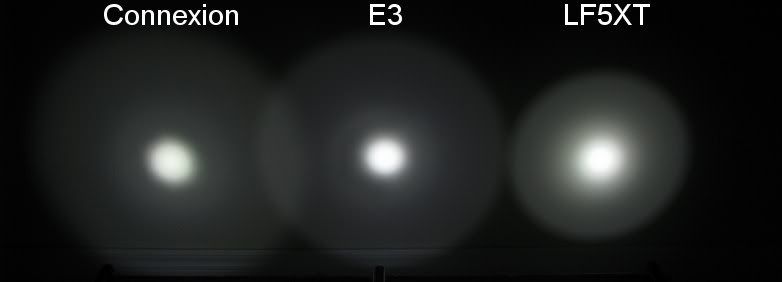
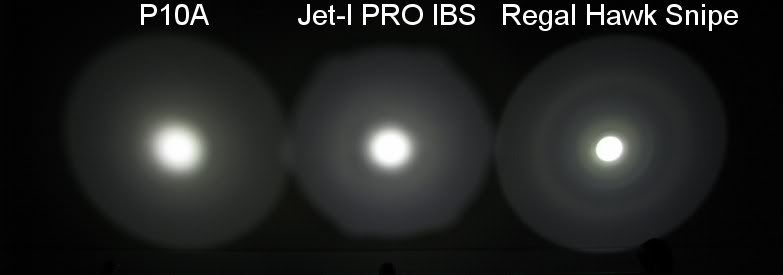
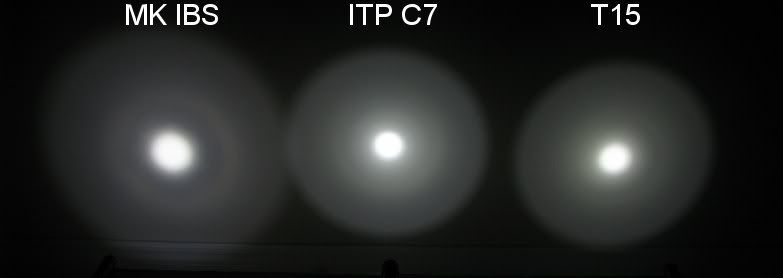
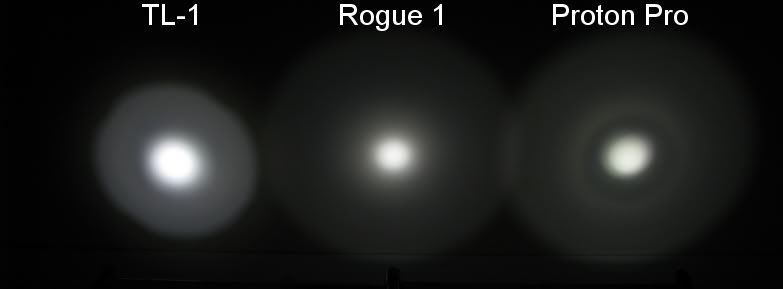
1/800sec, f3.2
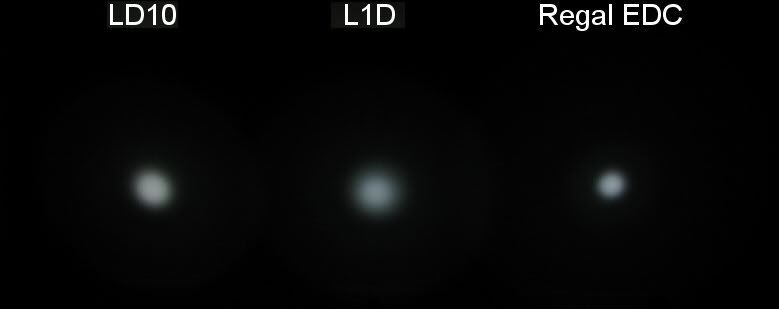
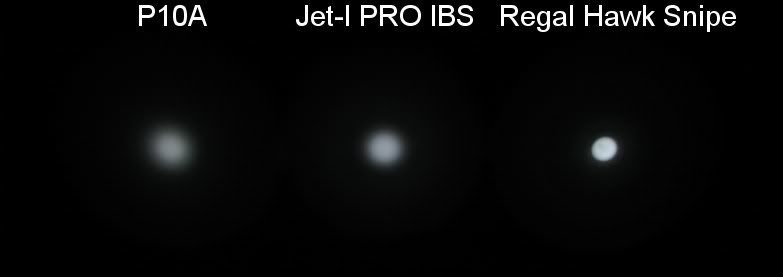
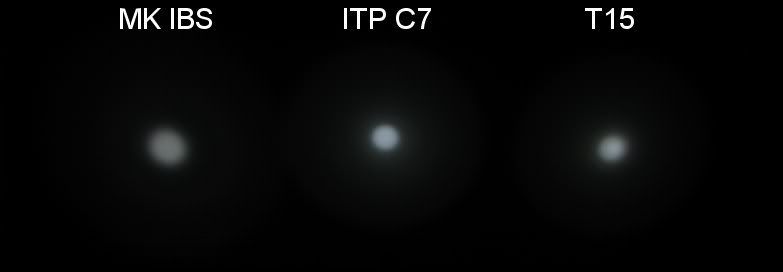
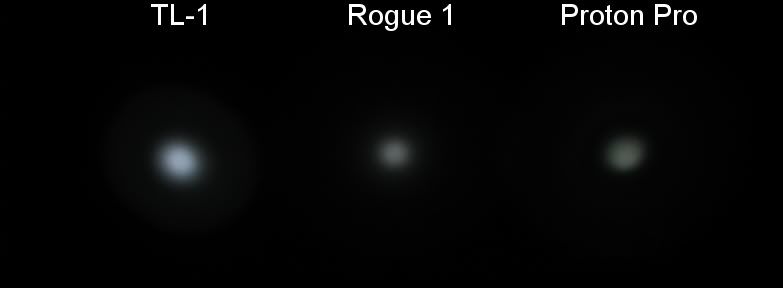
Note: although not shown, the Olight I15 has the same reflector and beam pattern as the Olight T15 and ITP C7 above.
Output/Throw Summary Chart
For all comparisons, Throw refers to the square-root of lux at 1m, taken with a lightmeter (raw lux values included in brackets). Max refers to the initial maximum output of the light in my lightbox (i.e. Max/Turbo/100%, depending on terminology used for that light). Min refers to the initial minimum output the light is capable of. Ceiling bounce refers to luxmeter measures taken on the floor of a small window-less room with the light in candle-mode (i.e. on the floor, pointed at the ceiling).
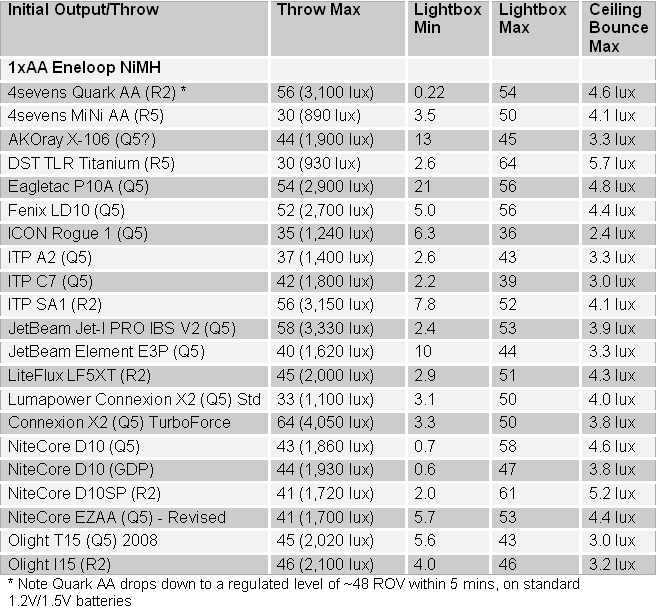
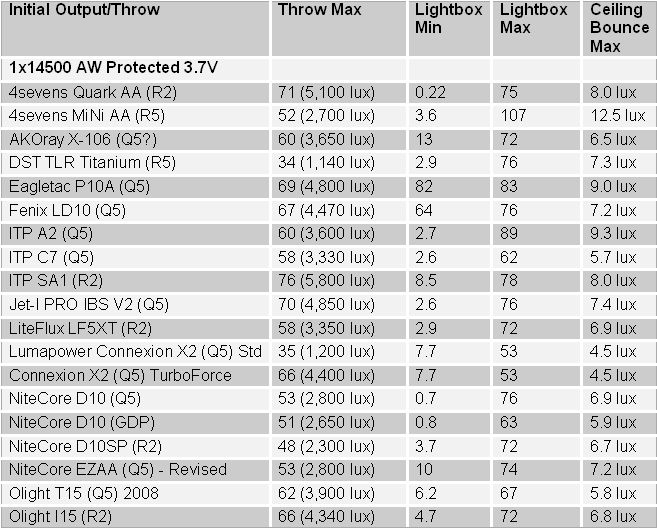
Ramping Comparison:
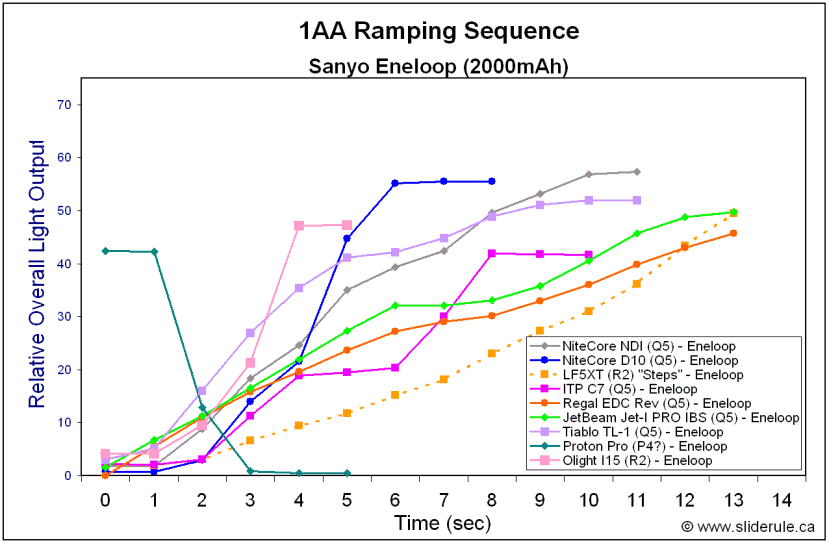
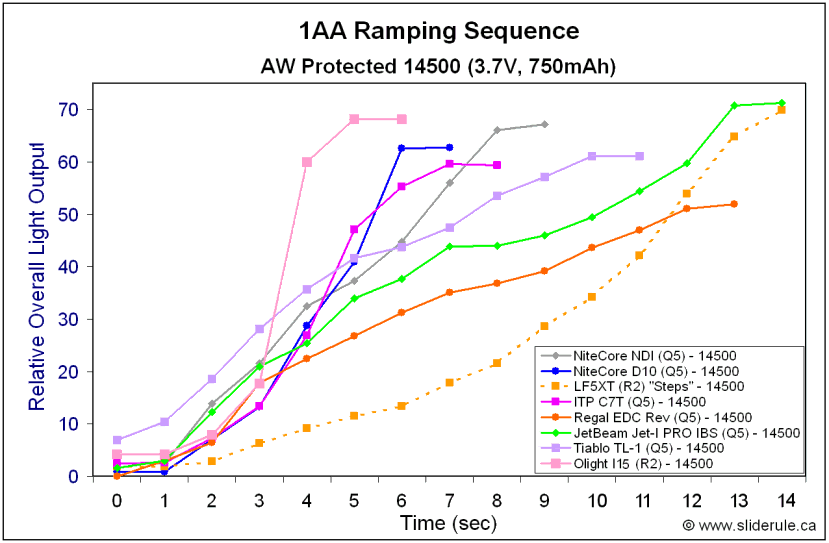
Note: the Liteflux LF5XT is only continuously-variable in its programming mode, which is non-visually linear and long running (>40 secs, not shown). The programming mode also allows you step through outputs in a visually linear manner, with ~14 discrete steps (shown above, with a dotted line).
Runtime Comparison
A comment on these graphs: There is a lot more to a light's performance than its runtime. I've tried to give some context for each light's overall performance and value in the individual light discussions at the end of the review. The purpose of these graphs is to simply let you quickly compare output/runtime at a glance. Note that there can be considerable variability in output and runtime between different samples of the same light.
Lo/Med/Hi typically refer to relative output levels on multi-mode lights (in some cases, Min=Lo, Max=Hi). For continuously variable lights, I have tried to match variable output to similar values of the fixed multi-mode lights.
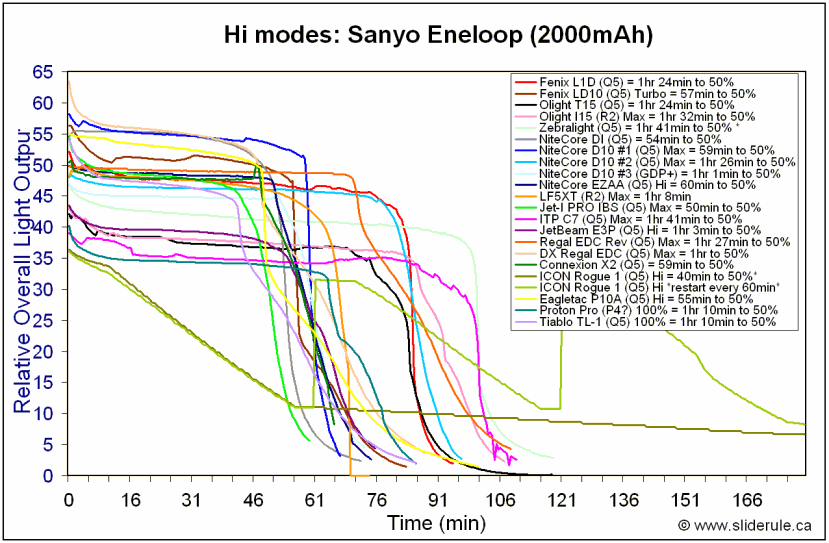
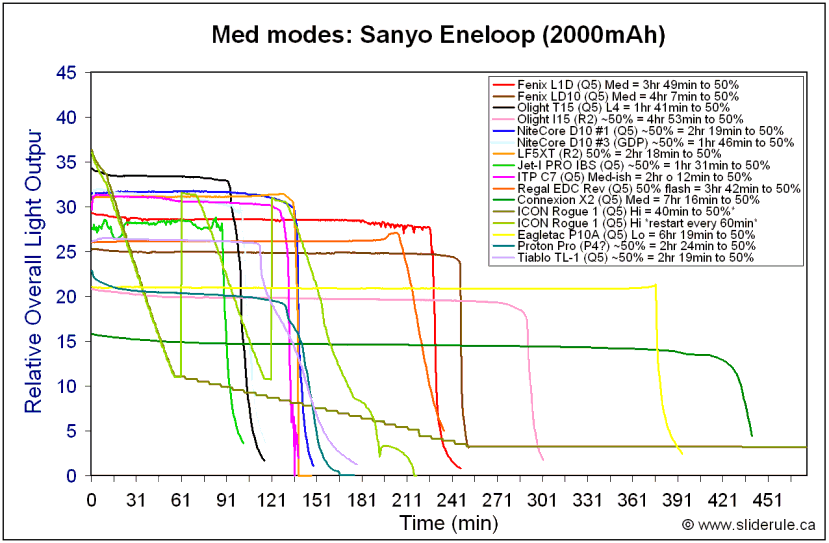
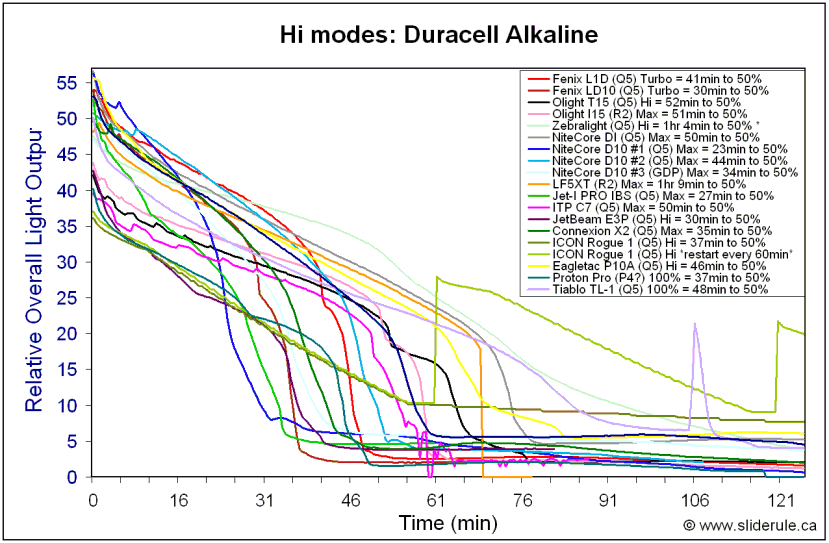
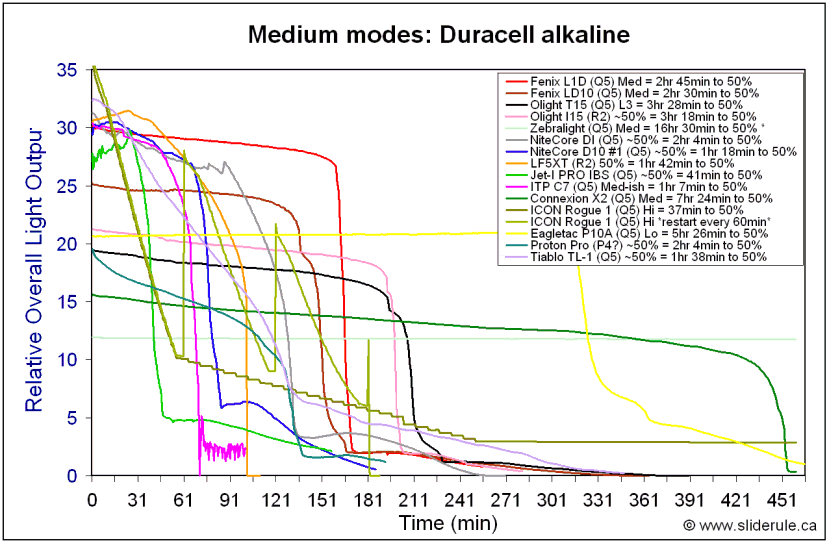
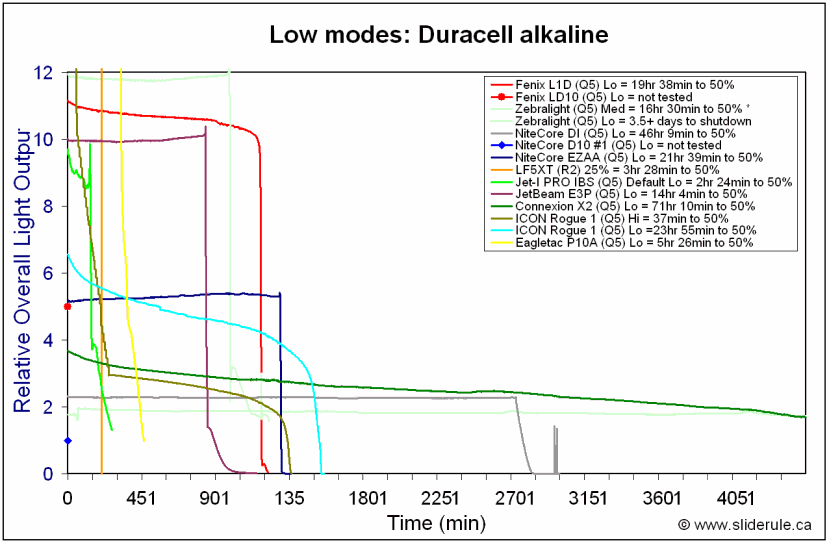
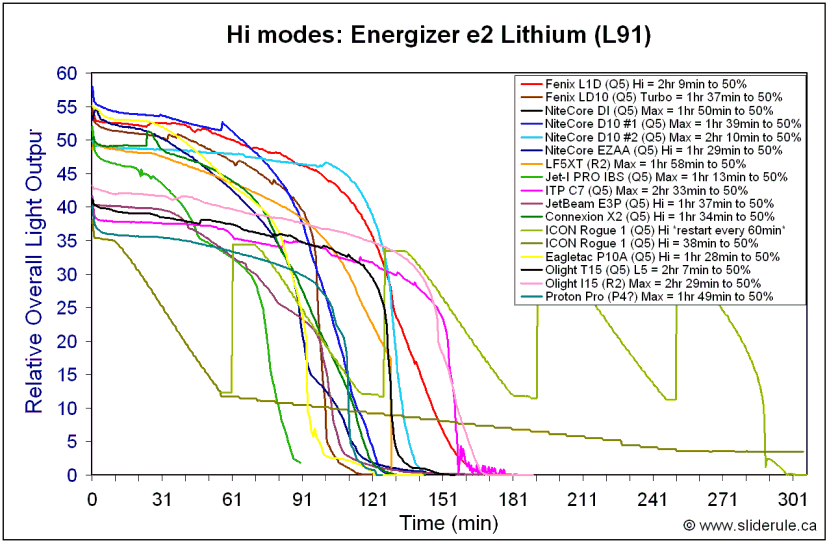
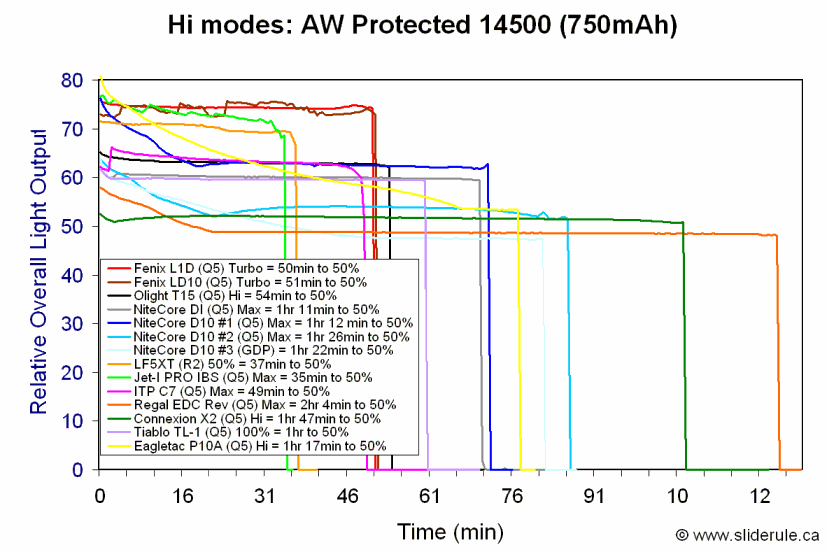
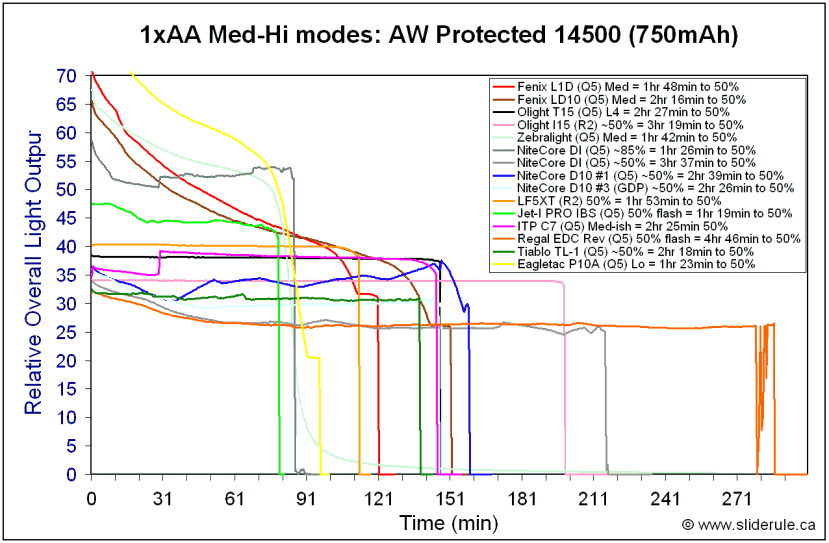
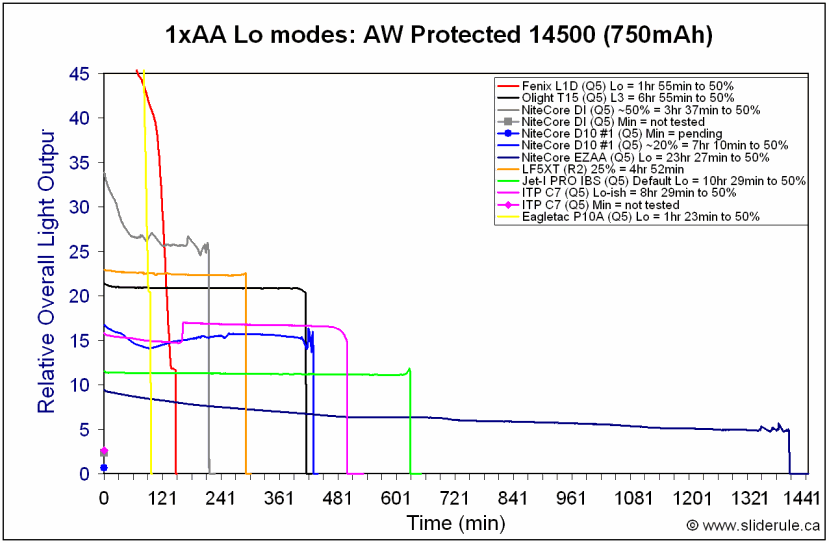
Light Reviews
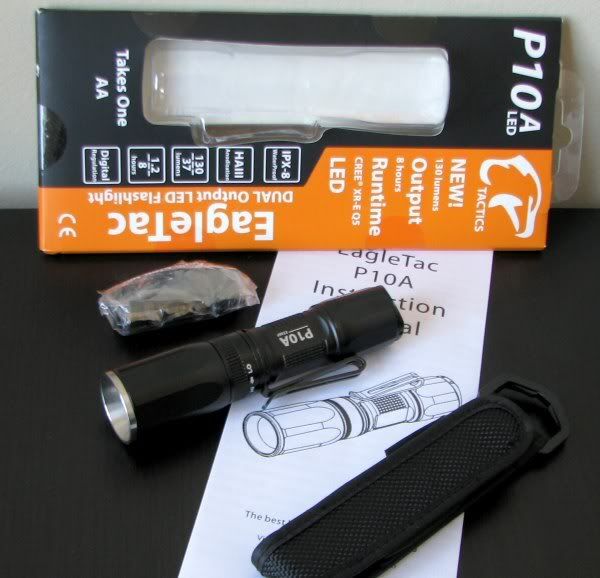
Eagletac P10A (Cree Q5):
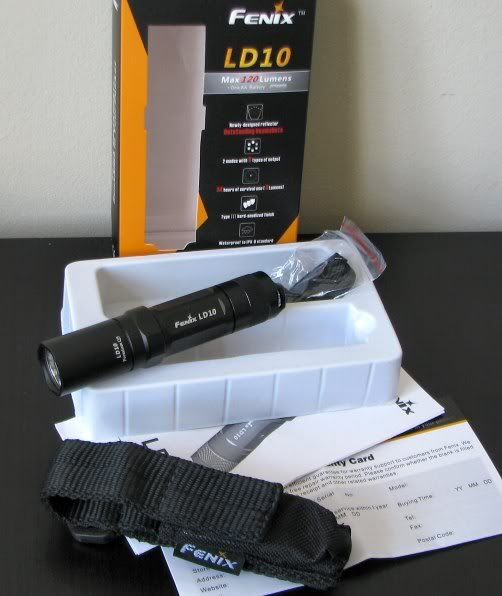
Fenix L1D and LD10 (Cree Q5):
L1D Comparison Review: Fenix Rebel vs Cree: L1D/L1T/P2D OUTPUT, RUNTIMES, BEAMSHOTS!
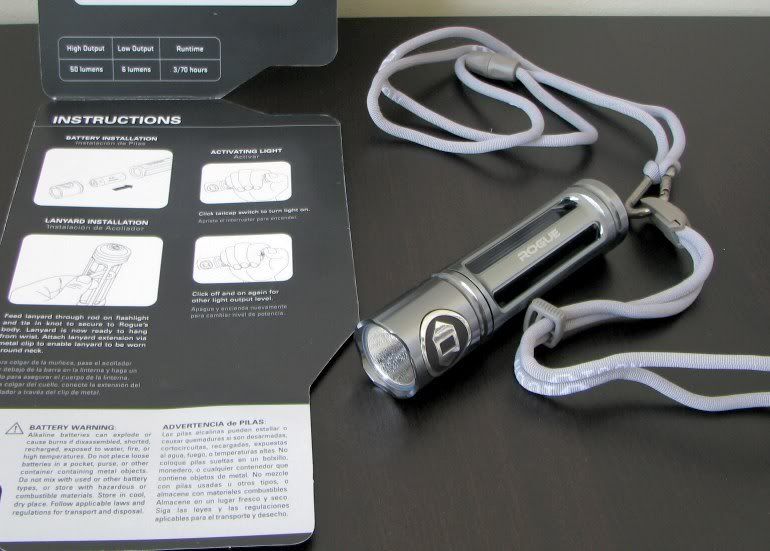
ICON Rogue 1 (Cree Q5):
Full review: ICON Rogue 1xAA Review: RUNTIMES, ANALYSIS, BEAMSHOTS and more!
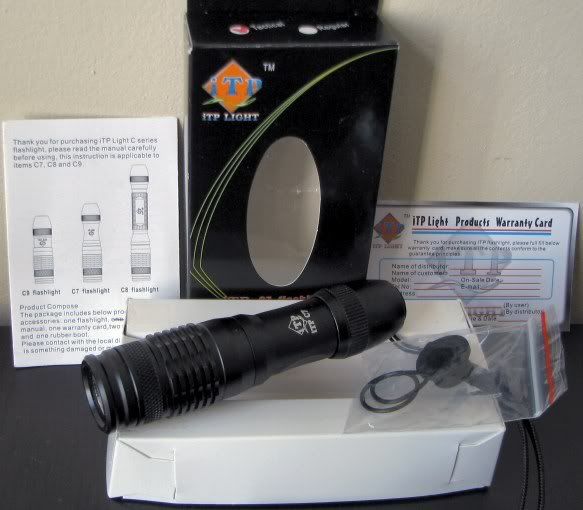
ITP C7 (Cree Q5):
Full Review: ITP C7 1AA Review - Regular and Tactical Versions - RUNTIMES, BEAMSHOTS, and more!
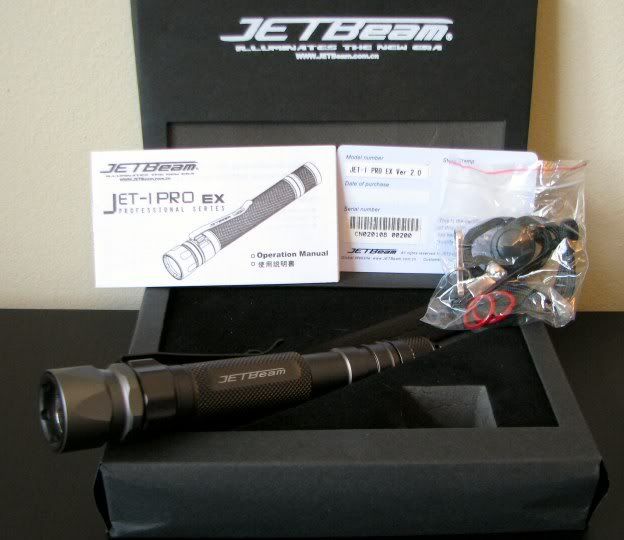
JetBeam Jet-I PRO IBS (Cree Q5):
Full review: JetBeam 2AA Jet-I PRO EX V2.0 Review: Comparisons with Jet-I PRO IBS and more.
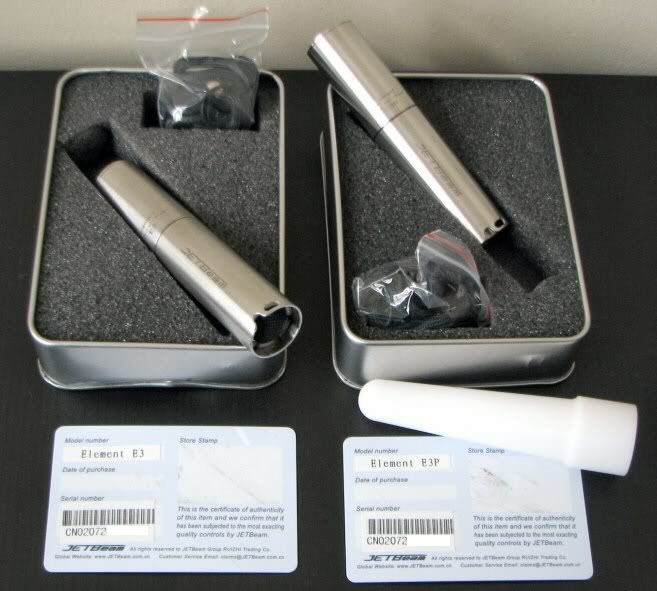
JetBeam Element E3P (Cree Q5):
Full review: JetBeam Element E3 & E3P Review: 1AA Stainless Steel lights
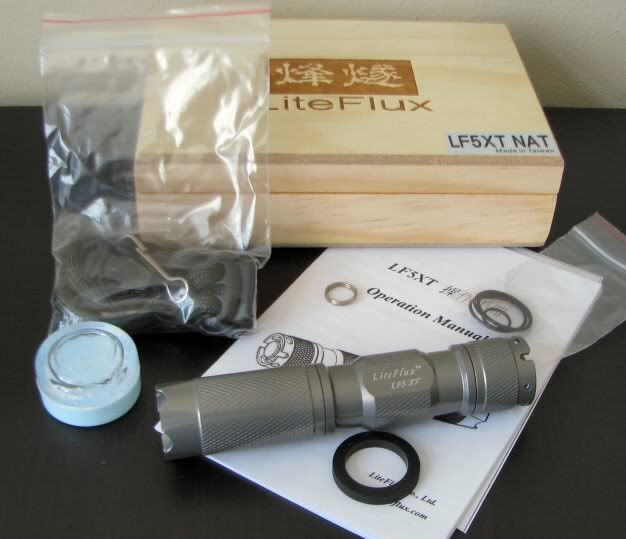
Liteflux LF5XT (Cree R2 - now with Q5):
Full review: LiteFlux LF5XT Review: RUNTIMES, BEAMSHOTS, COMPARISONS, and more!
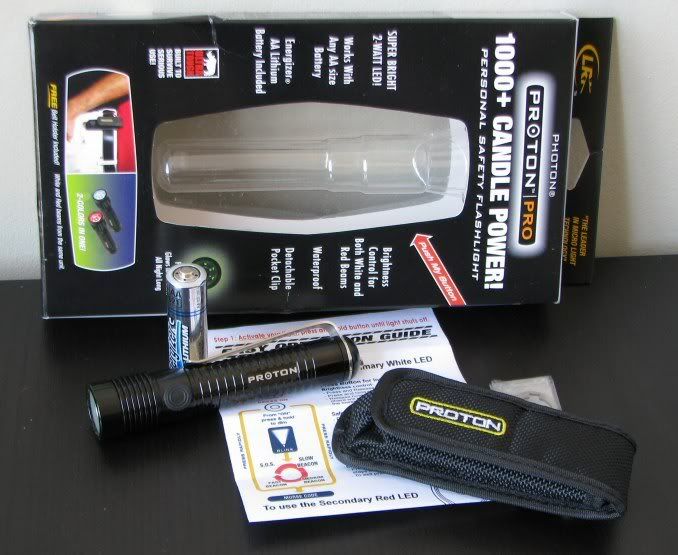
LRI Photon Proton Pro (Cree, unknown flux bin):
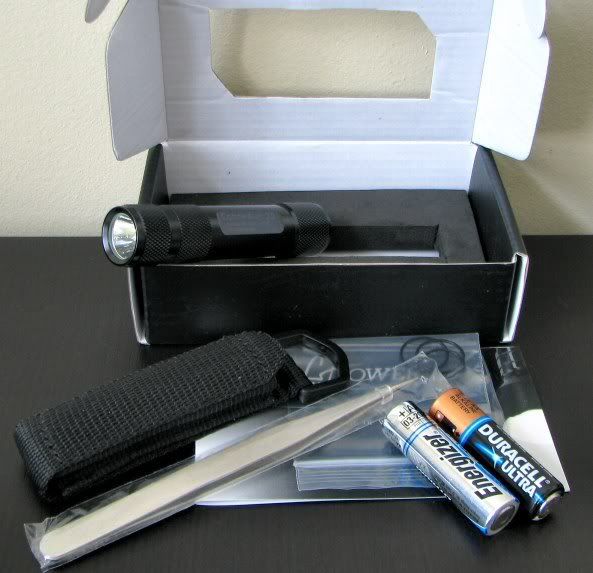
Lumapower Connexion X2 (Cree Q5):
Full review: Lumapower Connexion X2 Review (1AA): BEAMSHOTS, RUNTIMES, COMPARISONS, etc.
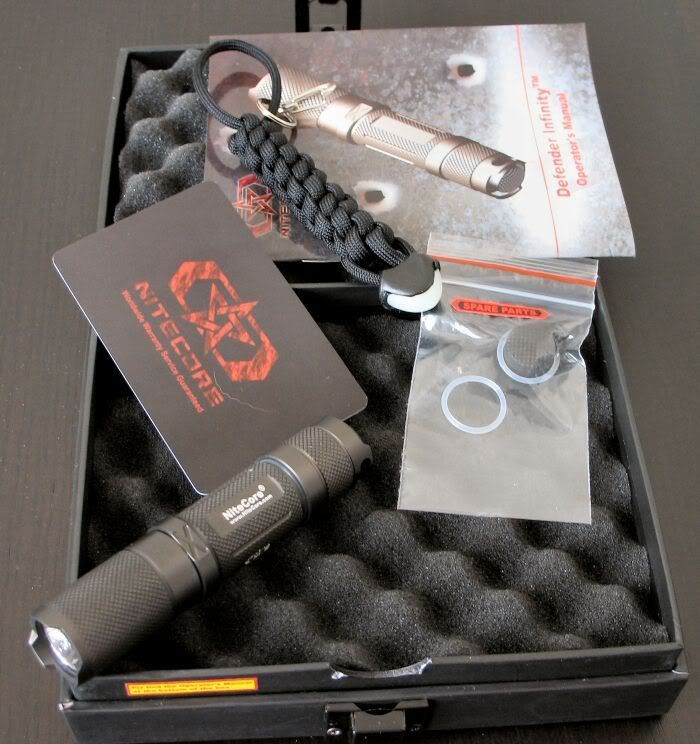
NiteCore Defender Infinity (Cree Q5 - now available with R2):
Full review: NiteCore Defender Infinity: shipping vs pre-production
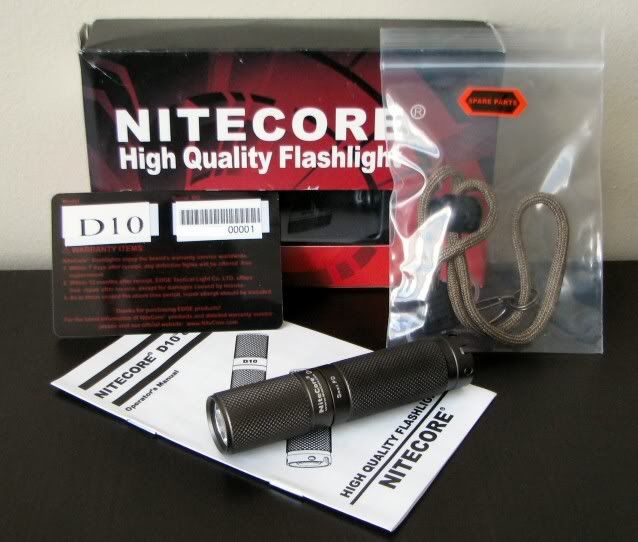
NiteCore D10 (Cree Q5 - R2 now available - also available with Golden Dragon Plus):
Full review: NiteCore D10 & EX10 Reviews: RUNTIMES, BEAMSHOTS, COMPARISONS & more!
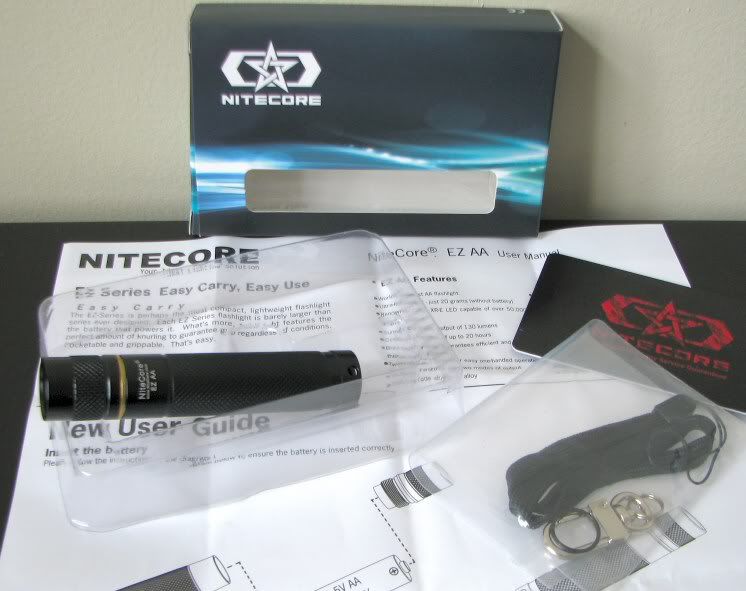
NiteCore EZAA (Cree Q5):
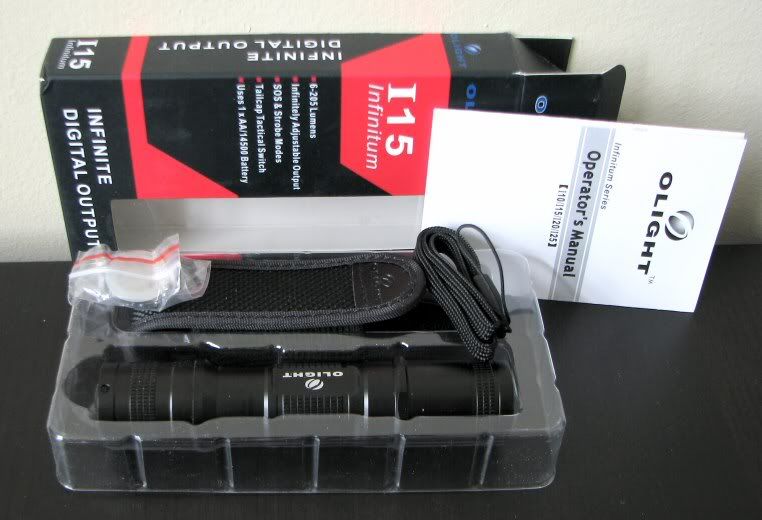
Olight I15 (Cree R2):
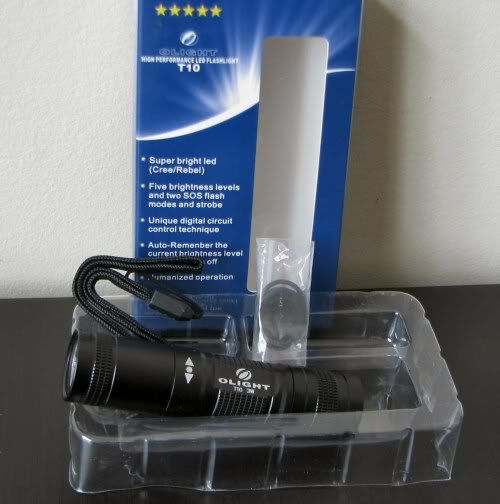
Olight T15 (Cree Q5):
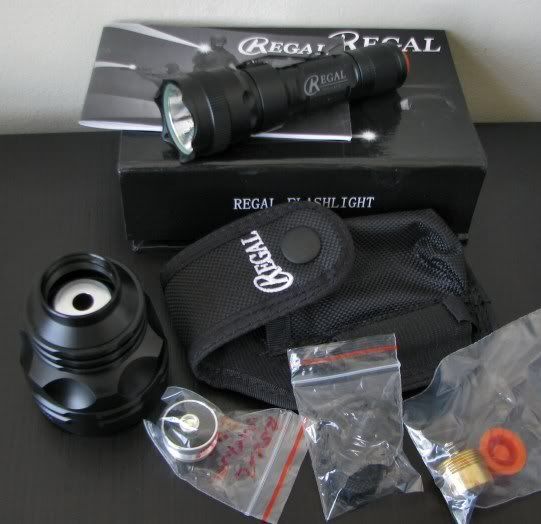
Regalight EDC (Cree Q5):
Full review: Regalight EDC Review (Original and Revised circuit): RUNTIMES, BEAMSHOTS, etc.
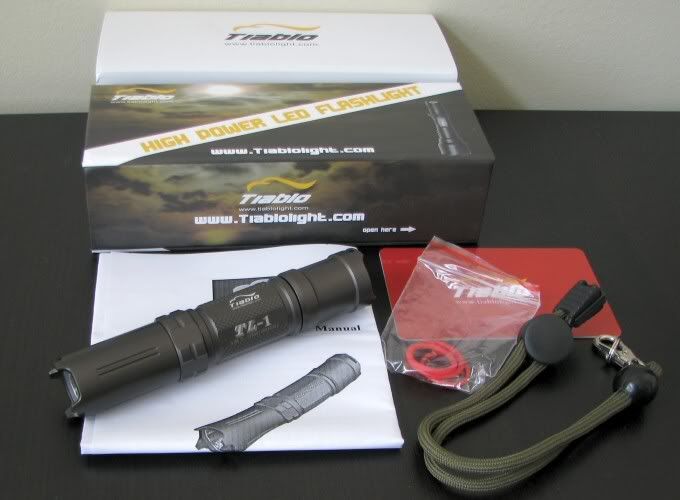
Tiablo TL-1 (Cree Q5):
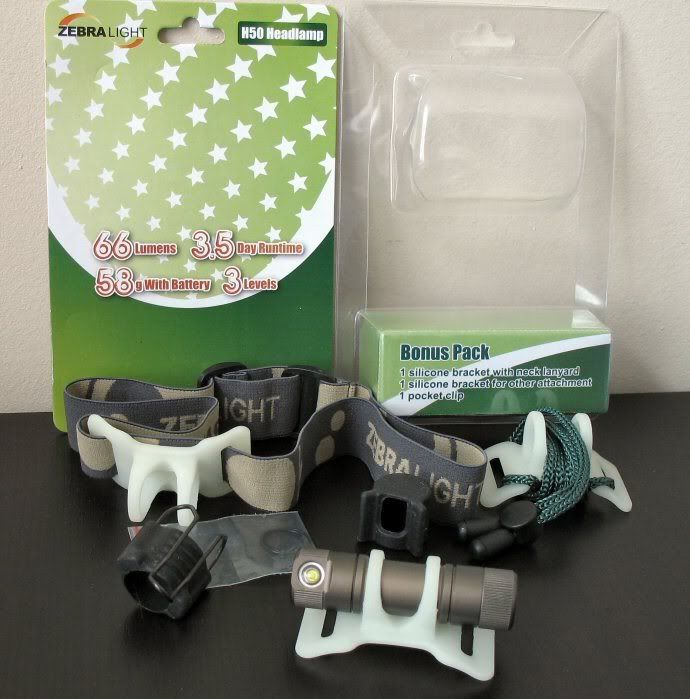
Zebralight H50 (Cree Q5):
Full review: Zebralight H50 Q5 1AA - BEAMSHOTS, RUNTIMES & more
UPDATE: Frequently Asked Questions (FAQs) :help:
Although there is too much info to easily summarize here, there are a few common questions that can be quickly addressed.
Which light has the most overall output?
Depends on battery type. On standard batteries (NiMH, alkaline) the Eagletac P10A and Nitecore NDI/D10 (Cree version) currently have the highest output in my testing. Note that max output on the D10 can be somwhat variable. On 14500, the Eagletac P10A, JetBeam Jet-I PRO IBS, and Fenix L1D/LD10 have the most output. Note that the P10A and Fenix lights lack all low modes on 14500.
Which light has the lowest Lo mode?
On standard batteries (NiMH, alkaline), the NiteCore D10 and LRI Proton Pro are capable of the lowest possible outputs. On 14500, the D10 retains the lowest low modes. But most of the PWM-based lights have fairly low Lo modes on all batteries, which may suffice for you.
Which light has the greatest throw?
Without question, the Regal EDC with Hawk Snipe Turbo head has the best throw. For standard 1xAA lights, the JetBeam Jet-I PRO IBS, Tiablo TL-1 and Eagletac P10A have the greatest throw on all batteries.
Which light is the most floody?
The Zebralight H50 is a true flood light - there is no reflector. The Lumapower Connexion X2, Regal EDC and Tiablo TL-1 have a removable head/reflector portion, and can therefore also run in pure flood mode.
With reflectors installed, none of these lights are particularly floody. The Lumapower X2 has the widest spillbeam, followed by the Regal EDC with standard bezel. The LRI Proton Pro, ICON Rogue 1, Lumapower X2, and NiteCore EZAA have the least amount of throw.
Which light has the smoothest beam profile?
All reflectored Cree-based lights are somewhat ringy, but the ICON Rogue 1 and Lumapower X2 have the smoothest beams (X2 is also somewhat focusable). The Nitecore D10 GDP version has a very smooth beam, although there is some tint variation across the beam (i.e. blue-tinted in the intermediate spillbeam). The NiteCore EZAA is also fairly smooth.
Which light is the most efficient?
The answer to this question depends on what specific output level you are interested in, and on what battery type (i.e. there is no universal answer). In general terms, "current-controlled" lights with pre-defined output levels are typically more efficient than PWM-based lights at those specific levels. However, PWM-based lights are typically capable of producing much lower output levels, which in turn translates into longer runtimes. You'll have to check out the runtime graphs to determine for yourself.
Which light is the best built?
I'm not touching that one with a ten foot battery tube. What I can say is that all the above lights are at least minimally acceptable in my books. Beyond that, you generally get what you pay for ...
What I can say is that all the above lights are at least minimally acceptable in my books. Beyond that, you generally get what you pay for ... 
Hope you found the detailed comparisons helpful! :twothumbs
To compare the current crop of 1xAA lights to earlier lights, please see my earlier 1xAA threads:
Part III: Liteflux LF5; Rexlight 2.1; Jetbeam C-LE v2, NiteCore Defender Infinity; Fenix L1D; Olight T15 (2007); LumaPower LM31; JetBeam Jet-I PRO (R2); Zebralight H50; JetBeam Jet-I MK IBS (Q5)
Part II: Rexlight 2.1; DealExtreme X.1; Jetbeam C-LE v1.2; Fenix L1DCE (Q2), L1D-R100, L1Tv2.0-R080; MTE 5-Stage Cree, 5-Stage R100; Kai 5-Stage Cree; Lumapower LM-301; Liteflux LF5; Ultrafire C3 5-stage
Part I: Rexlight 2.0; DealExtreme X.1, X.V; Jetbeam MK IIX, C-LE v1.0, C-LE v1.2; Fenix L1D-CE (P4)[/I]
For a discussion of the color rendition properties of different emitters and tint bins, please see my comparison thread: Color Rendition and Tint Comparison: Cree, Rebel, GDP, Nichia
Warning: this post is *very* pic and text heavy!

UPDATE June 10, 2009: Added Olight I15 and NiteCore EZAA to the review.
The contenders:


From left to right: Duracell alkaline battery; Eagletac P10A; Fenix L1D, LD10; ICON Rogue 1; ITP C7; JetBeam Jet-I PRO IBS, Element E3P; Liteflux LF5XT; LRI Proton Pro.


From left to right: Duracell alkaline battery; Lumapower Connexion X2; NiteCore Defender Infinity (NDI), D10-GDP; Olight T15; Regalight EDC; Tiablo TL-1; Zebralight H50.
Not shown are the Olight Infinitum I15 and NiteCore EZAA.
Size and weights (without battery):
Eagletac P10A: 76.1g
Fenix L1D: 48.7g
Fenix LD10: 48.9g
ICON Rogue 1: 85.7g
ITP C7: 76.4g
JetBeam Jet-I PRO IBS: 56.5g
JetBeam Element E3P: 105.0g
Liteflux LF5XT: 53.9g
LRI Proton Pro: 30.3g
Lumapower Connexion X2: 37.4g
NiteCore Defender Infinity: 44.1g
NiteCore D10: 41.3g
NiteCore EZAA: 20.9g
Olight I15: 52.5g
Olight T15: 53.3g
Regalight EDC: 63.6g
Tiablo TL-1: 61.3g
Zebralight H50: 18g
Testing Method: All my output numbers are relative for my home-made light box setup, a la Quickbeam's flashlightreviews.com method. You can directly compare all my relative output values from different reviews - i.e. an output value of "10" in one graph is the same as "10" in another. All runtimes are done under a cooling fan, except for the extended run Lo/Min modes that run for >24hrs - those are done without cooling.
Throw values are the square-root of lux measurements taken at 1 meter from the lens, using a light meter.
Beamshots:
All up-close beamshots are at ~0.5 meter from a white wall, on Max/Turbo/100% with a Sanyo Eneloop (NiMH).
1/25sec, f3.2






1/100sec, f3.2






1/800sec, f3.2




Note: although not shown, the Olight I15 has the same reflector and beam pattern as the Olight T15 and ITP C7 above.
Output/Throw Summary Chart
For all comparisons, Throw refers to the square-root of lux at 1m, taken with a lightmeter (raw lux values included in brackets). Max refers to the initial maximum output of the light in my lightbox (i.e. Max/Turbo/100%, depending on terminology used for that light). Min refers to the initial minimum output the light is capable of. Ceiling bounce refers to luxmeter measures taken on the floor of a small window-less room with the light in candle-mode (i.e. on the floor, pointed at the ceiling).


Ramping Comparison:


Note: the Liteflux LF5XT is only continuously-variable in its programming mode, which is non-visually linear and long running (>40 secs, not shown). The programming mode also allows you step through outputs in a visually linear manner, with ~14 discrete steps (shown above, with a dotted line).
Runtime Comparison
A comment on these graphs: There is a lot more to a light's performance than its runtime. I've tried to give some context for each light's overall performance and value in the individual light discussions at the end of the review. The purpose of these graphs is to simply let you quickly compare output/runtime at a glance. Note that there can be considerable variability in output and runtime between different samples of the same light.
Lo/Med/Hi typically refer to relative output levels on multi-mode lights (in some cases, Min=Lo, Max=Hi). For continuously variable lights, I have tried to match variable output to similar values of the fixed multi-mode lights.









Light Reviews

Eagletac P10A (Cree Q5):
- Like the P10A2 and P10C from my other round-up reviews, Eagletac lights use a basic 2-stage output system controlled by a twist of the head (similar to the Fenix LxT design).
- Like Fenix, Eagletac appears to use a current-controlled low mode (i.e. no PWM) that produces very good runtime for its output level. The Lo mode is still relatively bright on the P10A - I would consider the two states to be Regular and Turbo, instead of Lo and Hi.
- Like the P10C/P10A2, max output is extremely high on the Turbo mode, potentially highest in its class.
- Although the light can run 1x14500 Li-ion, it is not officially supported by Eagletac. Similar to the Fenix lights, you loose defined output modes, and the light seems to run on something close to a direct drive pattern (i.e. incredibly bright initial output, gradual decay).
- Note that the circuit on the P10A is different from the P10A2, which is optimized for 2xAA. See my discussion of the difference in this thread.
- Reflector design on the P10A is very good, with a deep textured reflector that produces a lot throw with little in the way of Cree rings. Overall spillbeam width is fairly typical for this class of light.
- Light uses a forward clicky switch that is recessed enough in the tailcap to still allow tailstanding.
- Light has anodized tailcap threads, allowing for lock-out.
- Comes with a bidirectional clip that allows attachment in both bezel up and bezel down modes. Note that placement of the clip interfers somewhat with your ability to unscrew the tailcap.
- Overall build quality is high, with a very solid feel.
- Light retails for ~$55.

Fenix L1D and LD10 (Cree Q5):
L1D Comparison Review: Fenix Rebel vs Cree: L1D/L1T/P2D OUTPUT, RUNTIMES, BEAMSHOTS!
- Fenix recently revised their classic P2D/L1D/L2D series with a new body design and nomenclature, now called the PD20/LD10/LD20. IMO, these changes are mainly cosmetic - most of the minor revisions to the circuit were quietly introduced to over time on the original series (e.g. reverse polarity protection, slightly lower Lo mode, etc).
- The head is interchangeable on these three body builds (1xCR123A, 1xAA, 2xAA). The new body plan features anti-roll additions to the body, a revised tailcap, and revised reflector with slightly more throw than the original design.
- Spillbeam width is slightly narrower on my LD10 compared to my L1D, but both are in the typical range for this class of light.
- The new head and body parts are also compatible with earlier P2D/LxD series parts.
- Whereas the original series was available with a range of emitters over the years (including the Cree P4, Q2, Q5 and Rebel 080 and 100), the new series lights all have Cree Q5 emitters.
- Fenix has remained the standard for excellent output/runtime efficiency on standard batteries. Note that my LD10 appears to have somewhat lower efficiency than my L1D-Q5, but this likely just reflects emitter variability from one sample to another.
- Although low mode output has been reduced from earlier models, it remains higher than many of the PWM-based lights reviewed here.
- On 14500 Li-ion, you loose all the low modes initially, as the light runs in direct drive from max output until it hits the prescribed lower mode output level. At that point, it then switches into regulation - but only briefly, as the battery is typically almost exhausted by then.
- Light comes with a reverse clicky and allows tailstanding. A protruding forward clicky is available from the L1T/L2T V2 series lights, but this is better suited to the simpler two-stage operation of those lights.
- User interface is excellent on the Fenix lights, IMO. Twist the bezel to switch between Min and Turbo output modes. In Min mode, soft-press the clicky to access Med-Hi-Strobe. In Turbo, soft-press to access SOS.
- Build quality is very good. Fit and finish is generally good, although I find the anti-roll edges on the new LD10 to be a bit sharp along the bottom. Fenix pouches are useful for carrying a number of 1xAA lights, although I personally prefer the original pouch of the LxD series.
- Lights feature tailcap lock-out and reverse polarity protection.
- Currently, the L1D-Q5 retails for ~$50, and the LD10 for ~$55.
ICON Rogue 1 (Cree Q5):
Full review: ICON Rogue 1xAA Review: RUNTIMES, ANALYSIS, BEAMSHOTS and more!
- The ICON Rogue lights feature a unique circuit that steps down in output at various rates when run continuously. Restarting the light restores full output.
- Output level and regulated circuit pattern is virtually identical across all standard battery types (as opposed to most lights, which differ on different batteries).
- Body design is also unique, with raised body tube flats (which I find are a bit too sharp). The Rogue 1 is currently the largest 1xAA light in my collection.
- Overall output/runtime efficiency is comparable to a good PWM-based light, but the non-traditional regulation pattern may not be attractive to flashlight enthusiasts.
- PWM frequency is detectable at non-max outputs (140 Hz during ramp down phase on Hi, 440 Hz on Lo).
- Thanks to the heavily textured reflector, beam profile is very smooth and even, with little evidence of Cree rings. Spillbeam width is slightly wider than typical for this class of light.
- The light cannot tailstand, but lock-out is available thanks to anodized threads in the head.
- MRSP is ~$38.

ITP C7 (Cree Q5):
Full Review: ITP C7 1AA Review - Regular and Tactical Versions - RUNTIMES, BEAMSHOTS, and more!
- The C7 is continuously-variable, with an innovative user interface: simply loosen the head to activate the ramp (i.e. no rapid switching required). To select your output level, tighten. See the full review for more info.
- Comes in a Regular version with strobe and SOS mode (soft-press the reverse clicky), or a Tactical version without strobe/SOS and with a protruding forward clicky.
- Output/runtime efficiency is good - about standard for a PWM-based continuously-variable light (PWM is at an undetectable frequency).
- Note that I have observed some variability in terms of max output on different C7 samples (not shown above, but my C7T is not as bright on max, despite having equivalent runtimes when matched for output).
- Build quality is good, with a two-stage textured/smooth reflector that appears identical to the early Olights (identical beam pattern).
- The head is interchangeable with the 2xAA body tube and 1xCR123A body tube/tailcap, sold separately (i.e. ITP C8 and C9). This allows you to play "lego" by buying different possible battery configurations for one light (i.e. Like Fenix P2/LxD series, Surefire E-series, etc).
- Regular format light can tailstand, but not the Tactical model. Both lights feature tailcap lock-out.
- ITP C7 retails for ~$40, and various body tube parts are available separately.

JetBeam Jet-I PRO IBS (Cree Q5):
Full review: JetBeam 2AA Jet-I PRO EX V2.0 Review: Comparisons with Jet-I PRO IBS and more.
- Note: the Jet-I PRO IBS is the same as the Jet-I PRO EX V2 (2xAA) shown above, but with a 1xAA battery tube. For all runtimes, I have run the head on my original Jet-I PRO body. The original Jet-I PRO was a limited production run with defined output levels and a Cree R2 emitter. It was replaced by a Q5 version with the continuously-variable IBS interface - the Jet-I PRO IBS.
- The Jet-I PRO IBS features a number of minor build changes from the original Jet-I PRO - most notably a slightly protruding reverse clicky that is easier to activate (but can still tailstand, if a bit wobbly) and a plan bezel ring (original Jet-I PRO had a brass ring).
- The IBS interface has also been revised from the earlier Jet-I MK IBS, and is adjusted for AA batteries (e.g. 50% flash and ramp are now visually linear for standard batteries). Max output on 14500 Li-ion is also reduced from previous iterations of the IBS circuit.
- Overall output/runtime efficiency of the IBS circuit is typically not as high as some of the newer continuously-variable lights.
- Jet-I PRO has one of the highest levels of throw of any of my 1xAA lights. Spillbeam width is slightly narrower than most lights of this class.
- Build quality is high, with type III anodizing, reverse polarity protection and tailcap lock-out.
- Current retail price ~$65.

JetBeam Element E3P (Cree Q5):
Full review: JetBeam Element E3 & E3P Review: 1AA Stainless Steel lights
- Note: The Element also comes in a Cree Q2 version - the E3 - with a rubber tailcap button instead of metal. Both are shown above (E3P comes with the diffuser).
- The Element lights are made of stainless steel, in a brushed nickel finish. Stainless steel is more structurally durable than aluminium, and can be buffed to a variety of finishes. But it is also heavier, less effective at transferring heat, and cannot be anodized (so no battery lock-out possible).
- The Elements are simple 2-stage lights, with mode switching controlled by a head twist (similar to Fenix LxT series and Eagletac lights).
- Max output and output/runtime efficiency are less than the current-controlled Fenix or Eagletac offerings, although efficiency on Lo is pretty good.
- Switch is a forward clicky, and the lights can tailstand.
- Current retail price ~$55.

Liteflux LF5XT (Cree R2 - now with Q5):
Full review: LiteFlux LF5XT Review: RUNTIMES, BEAMSHOTS, COMPARISONS, and more!
- The LF5XT features a fully programmable interface, similar to the Novatac 120P - but with more available features.
- The LF5XT originally shipped a Cree R2 emitter, but now comes with a Q5.
- Output/runtime efficiency is acceptable, although not quite as high as some lights with simpler interfaces.
- The light features an electronic switching mechanism, with a time delay between button press and circuit response.
- Build quality is high, and the light features a deep reflector for good throw but somewhat narrow spillbeam.
- Tailstanding is possible, as is tailcap lock-out.
- Original R2 version was ~$70, current Q5 version retail price is ~$60.

LRI Photon Proton Pro (Cree, unknown flux bin):
- The Photon Pro is fairly unique for this class, as it contains a secondary 5mm red LED in addition to the main white Cree emitter
- The location of the on/off switch is on the body of the light near the head (i.e. the traditional placement on standard consumer flashlights)
- The Proton Pro has been available for some time. Although my sample was purchased recently, it does not seem to be updated from earlier shipping samples.
- Main LED appears to be a Cree P4 on mine, based on its output/runtime characteristics. As such, max output is less than the Q5/R2 lights reviewed here. Overall efficiency for this class of emitter seems acceptable.
- User interface is based on the familiar Photon keychain line, and is continuously-variable with a noticeable PWM frequency of 180-200Hz (depending on output level). Additional strobe/SOS/beacon modes are also available.
- The main white LED can only be activated on Max, and then ramped down. However, the Min output level is nice and low.
- Ramp time is considerably faster than most continuously-variable lights (<2 secs), making it hard to select the exact level you want.
- The low-intensity red LED can be activated from off in an increasing ramp.
- Beam pattern of the main LED is somewhat ringy, with a large number of artifacts on my sample (likely due to the smooth reflector and red LED cut-out). Beam tint is a non-premium white (e.g. quite green on my sample).
- The red LED illuminates automatically as the battery nears exhaustion on white light mode.
- Build of this light emphasizes small size and ease of use. A thick tail-mounted bezel-pointed clip is included (removable).
- Light cannot tailstand (unless modified), and tailcap threads are not anodized (so no tailcap lockout possible).
- Tailcap battery contact is not a traditional spring, but a bent gold-plated contact arm that projects from the tailcap. Note that mine had to be adjusted down from the stock position, as it dented the first battery I inserted into the light (i.e. it is fairly stiff).
- Current retail price ~$50.

Lumapower Connexion X2 (Cree Q5):
Full review: Lumapower Connexion X2 Review (1AA): BEAMSHOTS, RUNTIMES, COMPARISONS, etc.
- The Connexion X2 is a revised version of the original Connexion - part of Lumapower's EDC line of KISS lights (i.e. keep it simple).
- The light has 3 output levels, controlled by a recessed forward clicky switch. No strobe/SOS modes included. Memory mode is activated if you leave the light on for more than 1 sec in any given mode.
- Light is current-controlled, and thus has good output/runtime efficiency.
- Low mode level is quite low for a current-controlled light, but now as low as some of the PWM-based continuously-variable lights. Note that total runtime on alkaline was ~4.5 days, with slowly decreasing output over that time. This is perhaps the most efficient light at this level in the round-up.
- Build quality has improved from earlier model EDC lights, and now features an accessible tailcap clicky with removable clip, type III hard anodizing, and other updates. Light remains ones of the smallest 1xAA lights available.
- Very smooth beam, with wider than typical spillbeam (both due to the relatively shallow reflector). The head portion with reflector can be adjusted somewhat for focus.
- Light can tailstand, although head/body lock-out is not possible.
- Current retail price ~$50.

NiteCore Defender Infinity (Cree Q5 - now available with R2):
Full review: NiteCore Defender Infinity: shipping vs pre-production
- The NiteCore Defender Infinity was the first continuously-variable PWM-based 1xAA light available. Although newer versions of this light are now out (see the D10 below), the original NDI is still available and a strong contender.
- User interface is fairly straightforward, with a head switch (loosen-tighten twist) required to activate the ramp or change modes (see review for more info).
- Output/runtime efficiency is good for a PWM-based light.
- PWM is at a high enough frequency to be undetectable by eye.
- Light is very well built, with a more aggressive look than typical in 1xAA lights.
- Type III hard anodized in a dark natural finish, also available in a non-anodized nickel-plated finish.
- Light comes with a forward-clicky (momentary mode) has a tailcap lock-out feature. Light cannot tailstand.
- Current retail price is ~$75 for Q5 versions, and ~$80 for the new R2 versions.

NiteCore D10 (Cree Q5 - R2 now available - also available with Golden Dragon Plus):
Full review: NiteCore D10 & EX10 Reviews: RUNTIMES, BEAMSHOTS, COMPARISONS & more!
- The D10 uses a revised version of the NDI circuit, with a new intuitive simple-to-use continuously-variable interface accessed by the tail (see full review).
- Light uses an innovative piston-drive mechanism without a clicky-switch (switching is controlled by a contact ring in the head).
- Output/runtime efficiency is good, similar to the NDI on which it is based. Note that I have observed some variability in terms of max output on different D10 samples (see Max runtime graphs for comparison of two D10-Q5 samples).
- Beam profile depends on the emitter choice. Cree emitter versions produce a fairly typical Cree beam profile (i.e. dark ring around the hotspot). GDP versions have a broader and wider corona around the hotspot, but with some bluish tint variation into the outer spillbeam. See my D10-GDP review for a through discussion of the differences.
- High quality build, type III hard anodized in a dark natural finish.
- Complete lock-out is not available, but partial can be achieved by entering into momentary mode (i.e. not fully tightened).
- Light is one of the smallest 1xAA lights available.
- Current retail price is ~$55 for GDP/Q5 versions, ~$60 for the new R2 versions.

NiteCore EZAA (Cree Q5):
- The EZAA is NiteCore's attempt to make the smallest possible 1xAA light, suitable for keychain carry.
oo:
- Light features a twisty interface with just two modes - 10 lumens and 130 lumens (tighten the head to activate the light on Low, tighten further to activate Hi).
- The original release of the EZAA had to be recalled due to unexpectly low output and runtime efficiency on Lo. The newly revised version has fixed the Lo mode issue - and added Li-ion (14500) support.
- Output/runtime performance is now consistent with the revised specs. Overall output/runtime efficiency on Lo is ok, but not as high as some of the defined-output constant-current competition.
- Beam is smooth with limited throw, and relatively free of Cree rings.
- Build quality is quite good for such a small twisty light - but as with all such lights, there is some concern over potential "battery crushing" if too much force is used to over-tighten the light on Hi.
- Also comes with a relatively warm "neutral tint" Cree emitter
- Currently retails new for ~$50.

Olight I15 (Cree R2):
- The Olight I-series lights are basically a merger of the older Olight T-series build with the ITP circuit and UI - both revised and tweaked in a new format with the latest R2 Cree emitters. :thumbsup:
- Build is similar to the T15 described below, with the addition of a protruding forward clicky and anti-roll ring.
- Circuit is similar to the ITP C7 described above, with a shortened ramp time and revised UI to support strobe/SOS with a tactical forward clicky.
- Please see the Olight Infinitum Round-up review for a greater discussion of the updates to this line.
- Light retails new for ~$55.

Olight T15 (Cree Q5):
- Note: The T10 (1xCR123A) and T15 (1xAA) use a common head/tail, with different body tubes. T10 is shown above, but packaging would be similar for the T15.
- Like Fenix, Olight uses a current-controlled circuit for its various output modes. Unlike Fenix, Olight's circuit can maintain regulated output on all levels on 3.7V Li-ions (Fenix is largely direct drive on 3.7V Li-ion). Note that this applies to the 2008 Olight models (the original 2007 versions had a virtually identical circuit to Fenix).
- Output/runtimes were generally excellent across the range of outputs. While the lowest setting is not as low the PWM-based competition, it is lower than some current-controlled lights. Note that the new Fenix LD10 has a similar low level.
- Light comes with a reverse clicky tailswitch, five output levels selected in sequence by a loosen-tighten switch of the head. Soft-pressing the tailswitch will move you into strobe followed by SOS modes. Light has a memory mode retaining the last level used.
- Spillbeam width is narrower on the T15 compared to most of the other Cree-based 1xAA lights, but overall output and max throw are similar to the original Fenix L1D-Q5.
- Light uses a two-stage hybrid reflector - textured at the base near the emitter (to smooth out Cree rings), smooth near the top (to improve throw). The same reflector is used in the ITP C7 shown above.
- Build quality is high. Light has a substantial feel.
- Anodized tailcap threads allow for lock-out, and light can tailstand.
- Light retails new for ~$50

Regalight EDC (Cree Q5):
Full review: Regalight EDC Review (Original and Revised circuit): RUNTIMES, BEAMSHOTS, etc.
- The Regalight EDC is a 1xAA light with optional Hawk Snipe Turbo head that could potentially rival the dedicated 18650 throwers (in theory).
- Unfortunately, initial release was plagued by several problems - including a malfunctioning circuit that caused a severe battery short on Max, faulty low battery warning, and a tailcap switch that couldn't handle the current demands.
- A revised circuit and switch were released that resolved these problems, but the light was driven at about half the promised maximal level. The official EDC thus has the lowest max level on 14500 of any light in my collection.
- Recently, a number of EDC lights have shown up on the discount deal sites, but the origin and provenance of these lights is unknown. At least one version seems authentic, and actually has considerably improved max output with similar efficiency (see my Regal EDC review for a comparison).
- Overall output/runtime efficiency is excellent for a PWM-based circuit.
- User interface is limited, with only a single saved state possible. Mode switching (including activation of the continuously-variable ramp) is a bit cumbersome.
- Spillbeam width on the standard head is wider than typical for this class, with good throw. The Hawk Snipe Turbo head produces outstanding throw with a typical spillbeam width.
- Overall build quality is good, although the body feels somewhat thinner and lighter than I would have expected. Type III anodizing and tailcap lockout are included.
- Current retail price is unknown - it is unclear if Regal is still in business. The origin and availability of EDC lights on the discount deal sites is unclear.

Tiablo TL-1 (Cree Q5):
- The TL-1 is a new 1xAA class light by Tiablo, previously best known for their 18650-based throwers (A8/A9/A10/ACE).
- The light has two set-able states, and includes a continuously-variable output ramp (uses PWM, but at an undetectable level). Second set-able state also includes options for various strobe modes (1-15 Hz), SOS and beacon locater modes.
- Three rapid soft-presses followed by a press-and-hold are required to activate the programming features. However, there is no visual or tactile feedback to assist you (i.e. too much force when pressing and the light flashes on - interrupting the sequence - too little force and the ramp won't activate). The switch on mine has a somewhat soft and "squishy" feel, compounding the problem. But I found the JetBeam, Nitecore, and Liteflux switches all took some time to get used to as well.
- More significantly, my sample is exceedingly difficult to program with a protected 14500 cell installed (compared to standard batteries).
- Min output is not quite as low as most of my other PWM-based continuously-variable lights. The ramp speed at the lower levels is faster than typical, making it difficult to select the extremely low levels (but the overall ramp is visually-linear).
- Throw is quite good, but overall spillbeam width is among the narrowest of lights in this class.
- The TL-1 is one of the longest 1xAA lights in my collection, with abnormally elongated strike bezel protrusions.
- Overall build quality is high, with natural type III hard anodizing.
- Light can tailstand (and headstand), and tailcap lock-out is available thanks to anodized threads. Note the head can be removed to allow the light to run in "candle" mode (i.e. bare emitter).
- The battery tube was originally labelled with the Regal logo, and subsequently covered up by an abnormally large white battery orientation logo (the original Regal logo is still faintly visible).
- Current retail price is ~$55.

Zebralight H50 (Cree Q5):
Full review: Zebralight H50 Q5 1AA - BEAMSHOTS, RUNTIMES & more
- Note: A new version of this 1xAA light (similar in build to the H30) has been announced - the H501. I have not seen a sample yet.
- Although often marketed as a headlamp, the H50 is a very versatile little light that is pure flood (i.e. no reflector).
- The H50 has 3 modes, accessed by a twist of the tailcap (i.e. twisty interface). Light comes on Low, and Med-Hi can be access in sequence by repeated off/on switch. There is no memory mode.
- Selection of output levels is good, with excellent output/runtime efficiency.
- The light may be current-controlled - if it uses PWM, the frequency is high enough that I can't detect it.
- Light lacks true low modes on 14500, and max output is extremely bright on my sample. This may have been revised on the recently announced update, the H501.
- Note that in Med/Lo, the light has a long "moon mode" on protected 14500 (i.e. doesn't just rapidly drop to zero output when the protection voltage is reached).
- Smallest 1xAA light in my collection - lack of switch and reflector makes this light not much bigger than a 1xAA battery. Weight of the bare light is a negligible 18g.
- Despite thin and lightweight nature, build quality is very good. Good machining and anodizing (type III - HA).
- Can tailstand (and headstand for that matter)
- In headlamp mode, the included silicone bracket holds the light fairly firmly, but has enough play so you can still rotate the light easily. This means that the light can also rotate on you inadvertently while you are moving around.
- Light retails for ~$65.
UPDATE: Frequently Asked Questions (FAQs) :help:
Although there is too much info to easily summarize here, there are a few common questions that can be quickly addressed.
Which light has the most overall output?
Depends on battery type. On standard batteries (NiMH, alkaline) the Eagletac P10A and Nitecore NDI/D10 (Cree version) currently have the highest output in my testing. Note that max output on the D10 can be somwhat variable. On 14500, the Eagletac P10A, JetBeam Jet-I PRO IBS, and Fenix L1D/LD10 have the most output. Note that the P10A and Fenix lights lack all low modes on 14500.
Which light has the lowest Lo mode?
On standard batteries (NiMH, alkaline), the NiteCore D10 and LRI Proton Pro are capable of the lowest possible outputs. On 14500, the D10 retains the lowest low modes. But most of the PWM-based lights have fairly low Lo modes on all batteries, which may suffice for you.
Which light has the greatest throw?
Without question, the Regal EDC with Hawk Snipe Turbo head has the best throw. For standard 1xAA lights, the JetBeam Jet-I PRO IBS, Tiablo TL-1 and Eagletac P10A have the greatest throw on all batteries.
Which light is the most floody?
The Zebralight H50 is a true flood light - there is no reflector. The Lumapower Connexion X2, Regal EDC and Tiablo TL-1 have a removable head/reflector portion, and can therefore also run in pure flood mode.
With reflectors installed, none of these lights are particularly floody. The Lumapower X2 has the widest spillbeam, followed by the Regal EDC with standard bezel. The LRI Proton Pro, ICON Rogue 1, Lumapower X2, and NiteCore EZAA have the least amount of throw.
Which light has the smoothest beam profile?
All reflectored Cree-based lights are somewhat ringy, but the ICON Rogue 1 and Lumapower X2 have the smoothest beams (X2 is also somewhat focusable). The Nitecore D10 GDP version has a very smooth beam, although there is some tint variation across the beam (i.e. blue-tinted in the intermediate spillbeam). The NiteCore EZAA is also fairly smooth.
Which light is the most efficient?
The answer to this question depends on what specific output level you are interested in, and on what battery type (i.e. there is no universal answer). In general terms, "current-controlled" lights with pre-defined output levels are typically more efficient than PWM-based lights at those specific levels. However, PWM-based lights are typically capable of producing much lower output levels, which in turn translates into longer runtimes. You'll have to check out the runtime graphs to determine for yourself.
Which light is the best built?
I'm not touching that one with a ten foot battery tube.
Hope you found the detailed comparisons helpful! :twothumbs
Last edited:



